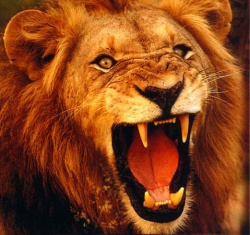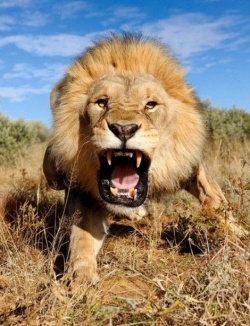The lion - symbolism
In the symbolism of the elements associated with the fire, the lion represents courage, supreme power, nobility and pride.
It acts as a solar symbol, and is also dedicated to solar deities (for example, the Vedic god Mitra).
The form of a lioness is to emphasize the concept of motherhood along with sensuality, in fact, in many cultures the lioness represents a sacred animal of the goddess-mother (for example, Ishtar was depicted standing on a lion, as well as Cybele was drawn in her chariot by lions).
The lion is the image of royalty and the embodiment of heroic onset.
In Buddhism, the lion symbolizes courage, dignity and stability.
It is believed that Buddha, in one of his incarnations had the appearance of a lion.
In China, the lion was associated with the idea of power.
Among animals, the lion often symbolizes the light side.
Characteristics of the lion can be seen in images of mythical creatures, such as the sphinx, the griffin and the chimera.
The images of lions which guard are common in Egypt, Assyria and Babylonia, India.
In medieval bestiaries, the lion has the ability to sleep with open eyes, and for this reason, it is also perceived as the embodiment of a careful watch.
In heraldry, the lion represents strength, virtue and prudence.
The lion in Christianity stands out as ambivalent.
The roar of the lion is similar to the word of God and the devil, "as a roaring lion."
The lion, as it is interpreted by Jerome, symbolizes evangelist Mark, who announces the royal dignity of Christ.
It is also the emblem of the Son of God and has a soft spot for contemplation, asceticism and solitude.
At the same time, the lion stands as the embodiment of the forces of evil and chaos, Dante describes it as a symbol of pride.
In many esoteric traditions, the lion is a symbol of the sun.
In Masonry, the lion represents power and glory and the upper part of the Royal Arch, where the sun turns during the summer solstice.
In the mysteries of Mithras, those who have successfully passed the tests are called "lions".
The prophecy of Isaiah provides the biblical symbolism of the lion that is resting quietly next to the sheep.
In Christian legend, we can see them together with Daniel in the lions’ den.
For Jung, the lion in the nature is a symbol of hidden passion, can indicate the risk of being absorbed by the unconscious.
In alchemy, the lion is a symbol of the raw untreated material.
In combination with three other animals, it is an element of the earth.
The Lion of the Earth is the enemy of the heavenly eagle, the master of nature, a spokesman for the strength and support of the male principle.
It is a symbol of real "red".
The winged lion is the element of fire, "philosophical fire."
Two lions represent the constant struggle, sunlight, morning, royalty and victory.
In Greece, the lion was the emblem of the calendar.
In spring Dionysus could take the form of the lion.
In the heraldic systems the lion means prudence, firmness and fortitude.
As an emblem, the lion is a symbol of courage, strength, generosity and mercy.
"To get rid of your love, you must become a lion," thus spoke Zarathustra.
The lion is depicted in the coat of arms of the state of Sweden, the United Kingdom, the Netherlands, Czechoslovakia, Bulgaria, India, Iran, Canada and Spain.

